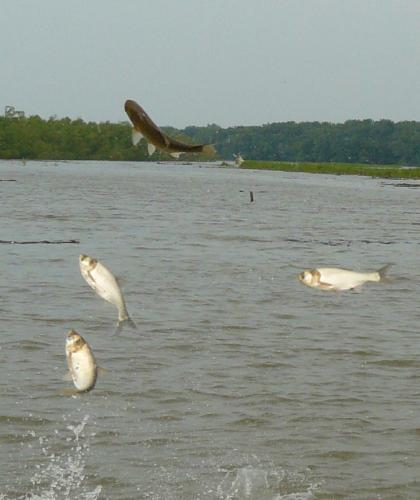Asian Carp – how can we stop them? (Part 3)
High-flying, plankton-guzzling fish are at the doorstep of the Great Lakes. Some progress has been made in recent years, but there is plenty left to do.
What is being done?
The Asian Carp Regional Coordinating Committee released its Control Strategy Framework in July 2013. The framework includes updates on current control projects and l ists planned funding for FY 2013 at $51.2 million. Some accomplishments include:
ists planned funding for FY 2013 at $51.2 million. Some accomplishments include:
Eagle Marsh in Indiana is a wetland between the Wabash River and Maumee River watersheds. The two watersheds connect during floods, which could allow silver carp to move from the Wabash system into the Maumee, which feeds into Lake Erie. In 2010, a chain link fence was built to prevent adult carp from moving between watersheds. In 2013, the U.S. Army Corps of Engineers options for a more permanent solution were narrowed to two options involving the building of earthen berms at a cost of $5.5 to $7.7 million.
The Des Plaines River runs adjacent to the Chicago Sanitary and Ship Canal. During floods, water from the Des Plaines River spills over into the canal. Asian carp and other invasive species could bypass electric barriers on the canal via the Des Plaines River. In 2010, thirteen miles of chain-link fencing and concrete were built along the narrow strip of land that separates the Des Plaines River from the canal.
While fences are a relatively new tool for carp control, operation of electric barriers in the Chicago area began in 2002. Most recently, voltage and frequency at Barrier IIB was increased in October 2011. Prior to that time, fish shorter than 5.4 inches could have moved through the electrical field at the barrier.
More detail on these projects and monitoring/removal efforts can be found at asiancarp.us.
Are current prevention measures sufficient?
Prevention measures may have improved in recent years, but ecological separation in the Chicago area would go beyond current measures. Some control tools (e.g., fences) are specific to fairly large fish. Others, like the electrical barriers, are adaptable enough to block fish in a wider range of sizes but do nothing to block hitchhiking mussels. Plankton and larval fish could also flow downstream through electric barriers, and the Mississippi Basin has already received several invaders from the Great Lakes. True ecological separation of the two basins would require no exchange of any invasive species.
Can’t we just dam the CAWS and be done with it?
Not really. Building a wall might stop invaders, but it will also cause widespread flooding and sanitation problems during heavy rains unless storm water infrastructure is updated accordingly.
In 2012, the Great Lakes and St. Lawrence Cities Initiative and Great Lakes Commission developed three options for Restoring the Natural Divide that ranged in cost from $3.26 to 9.54 billion. The options include plans for improving infrastructure in the Chicago area, which accounts for the hefty price tags.
Congress passed legislation mandating completion of a federal investigation into separation options by the end of 2013. However, there is no requirement to act on any of the options for separation once the federal study is completed.



 Print
Print Email
Email


